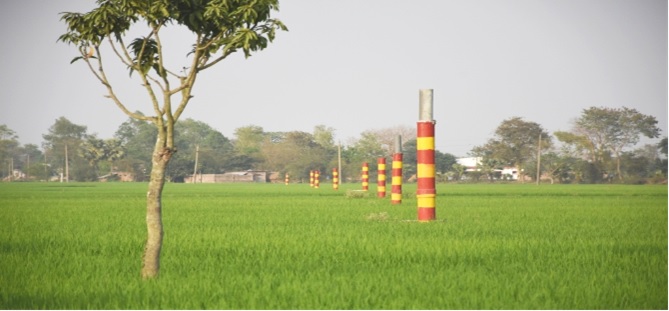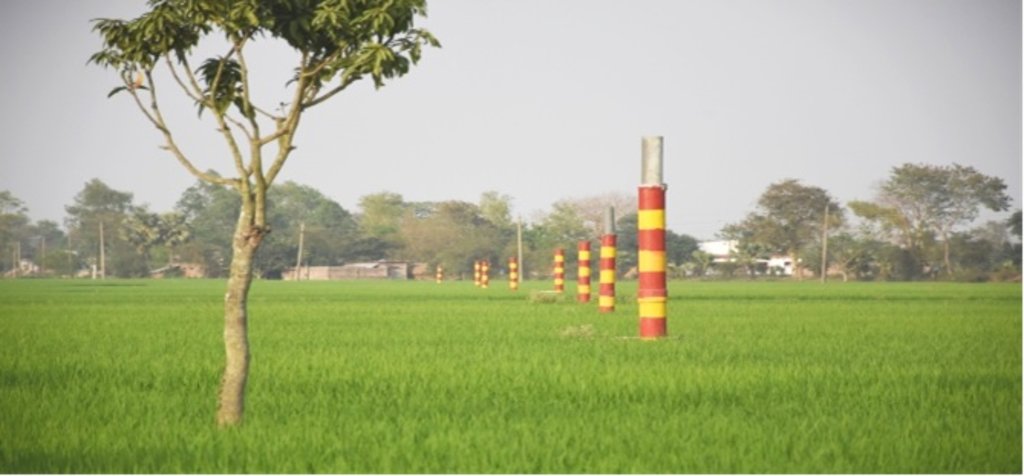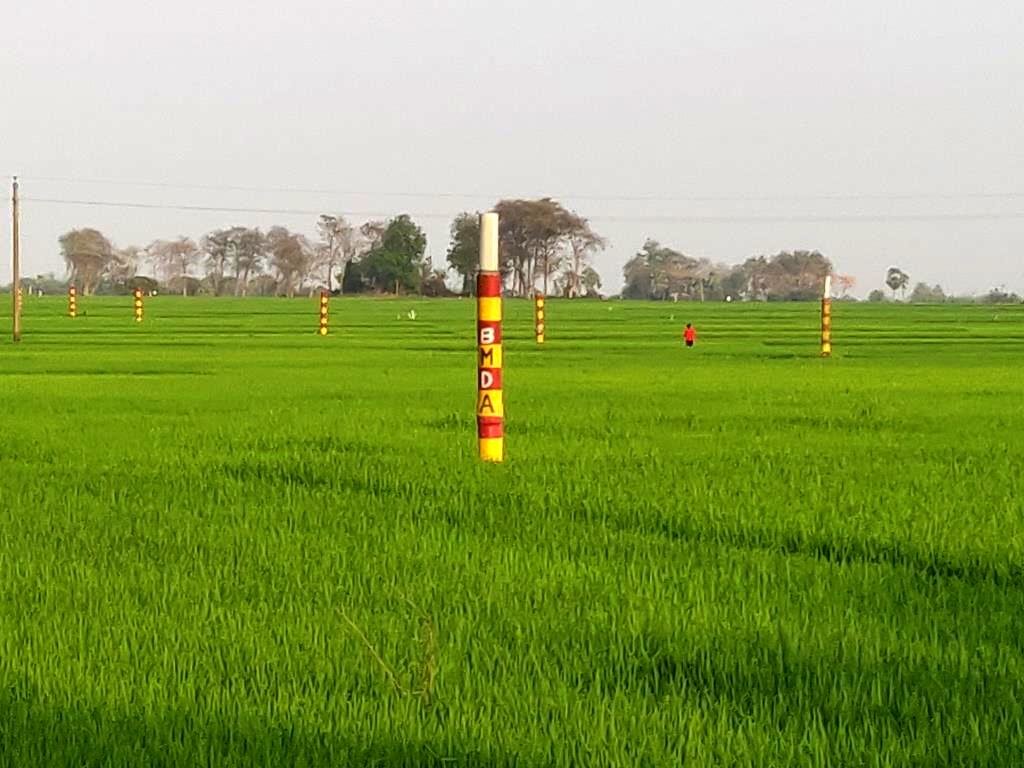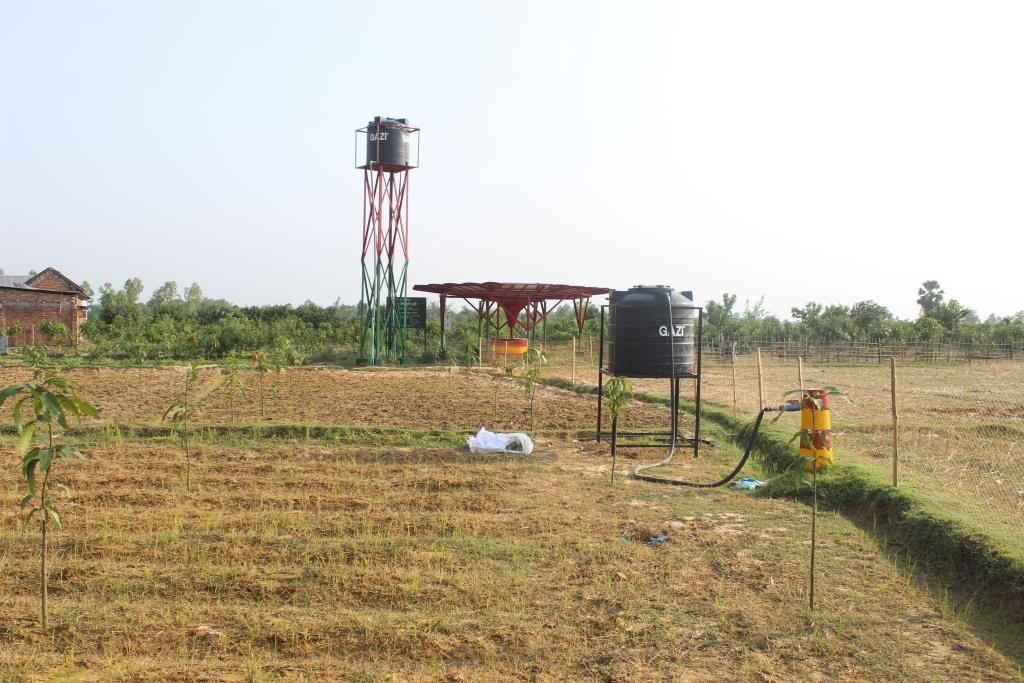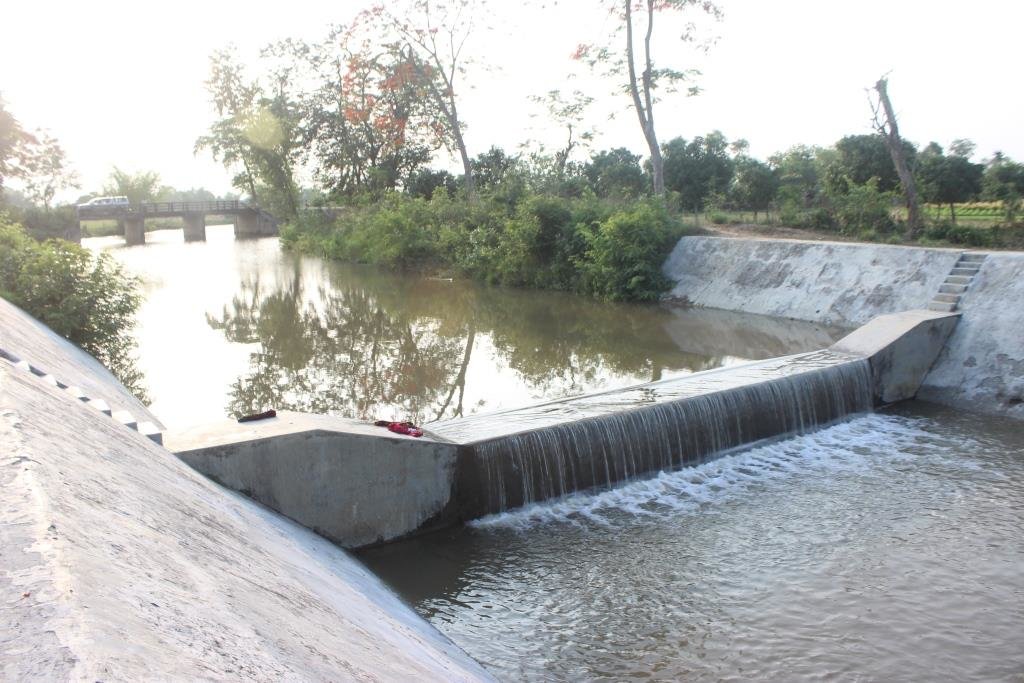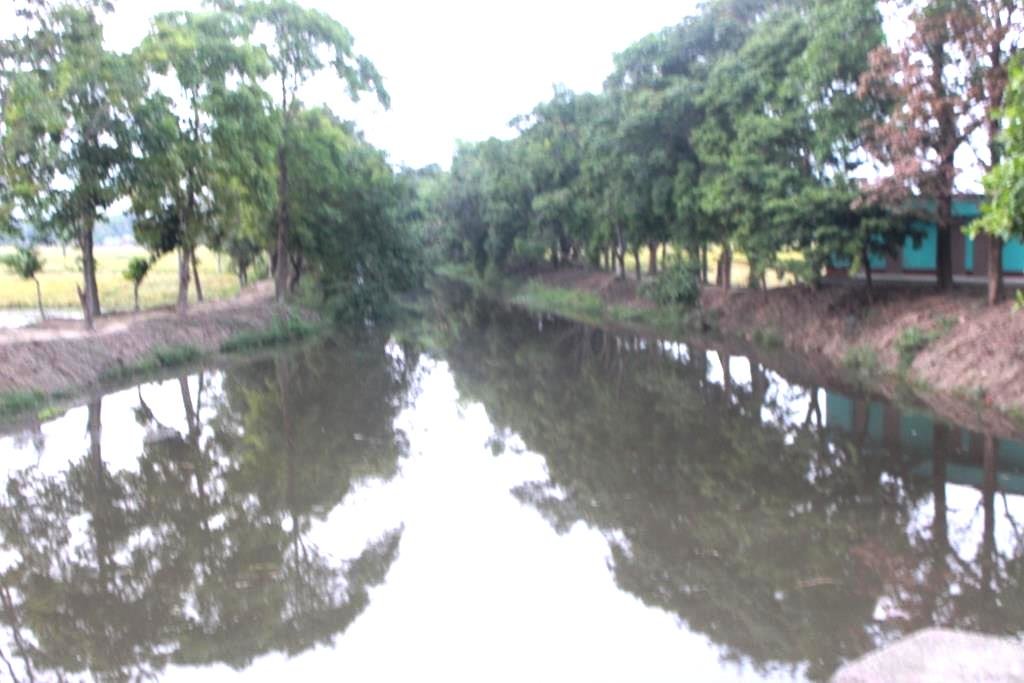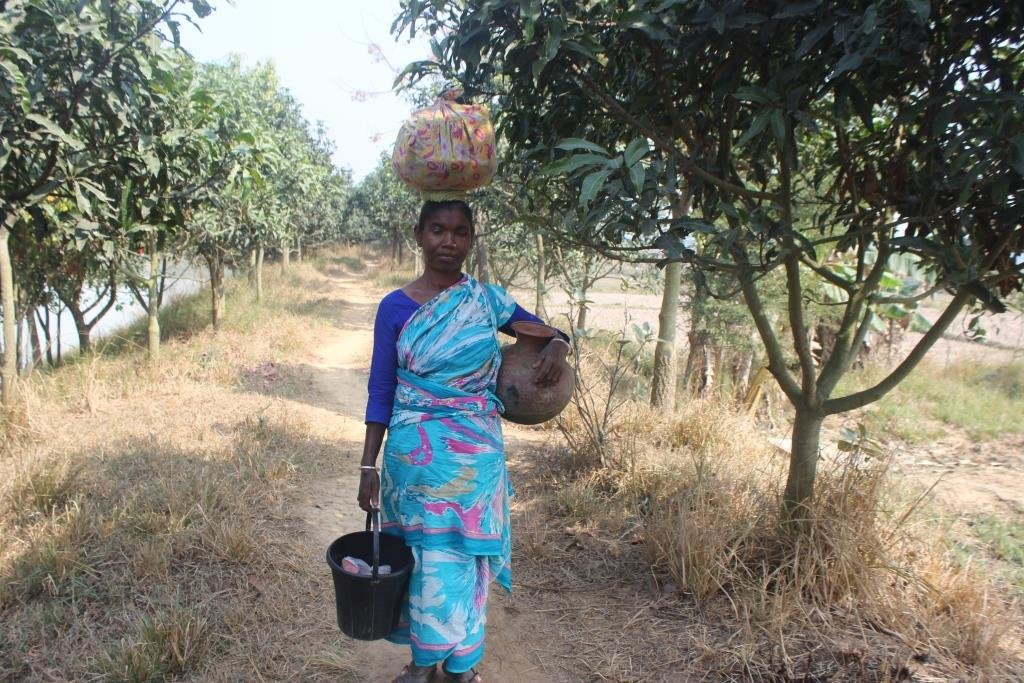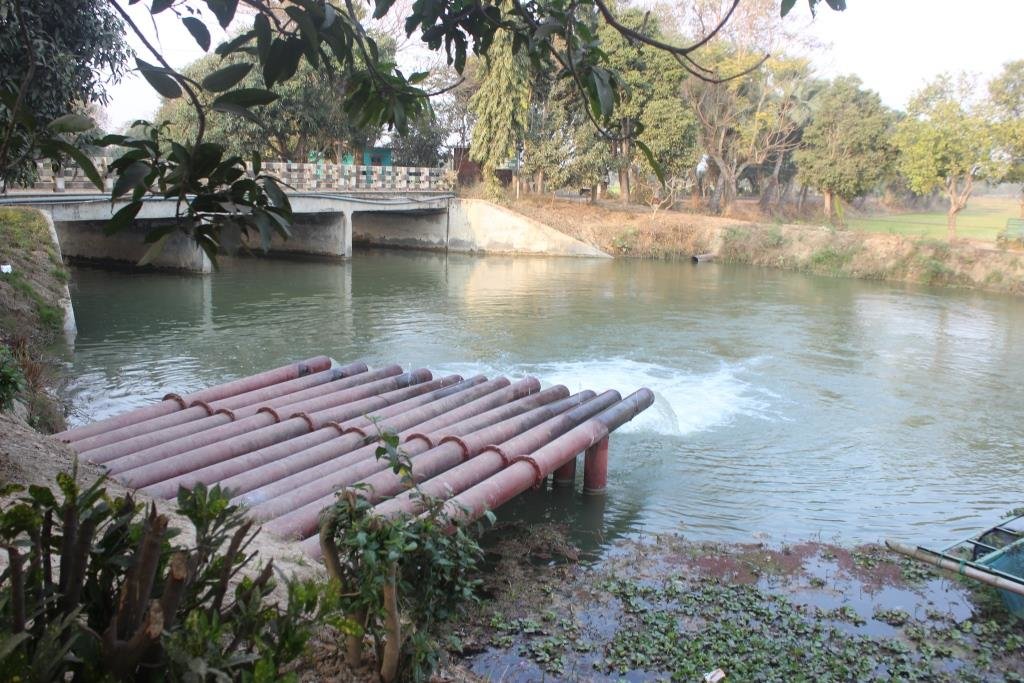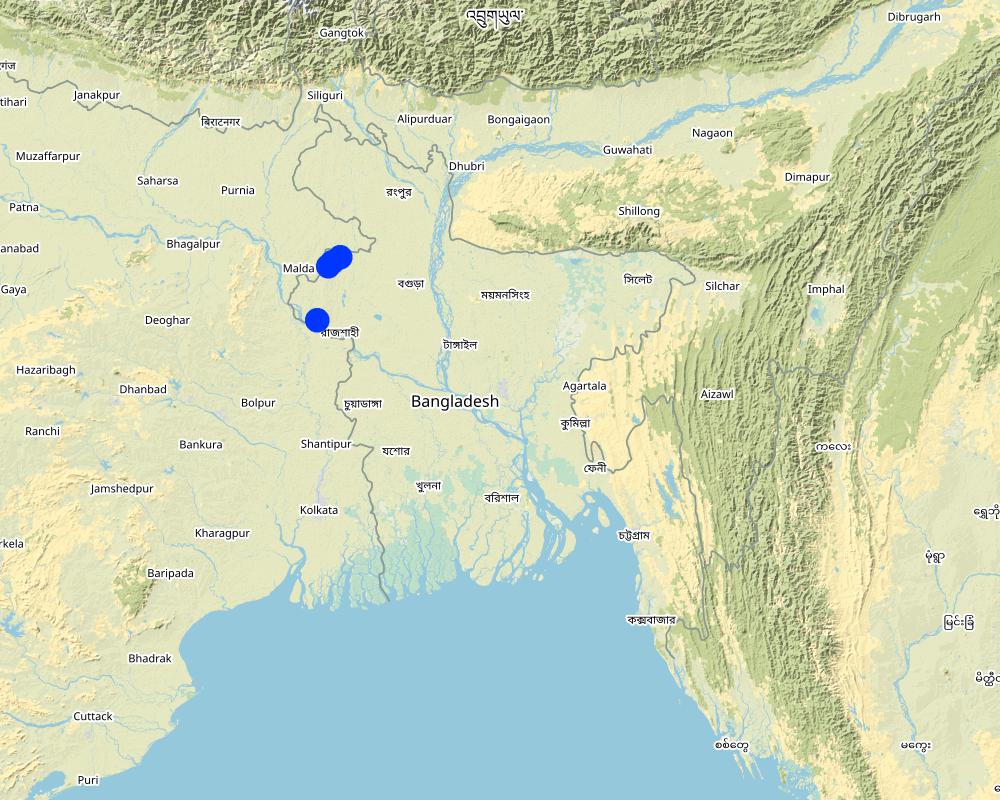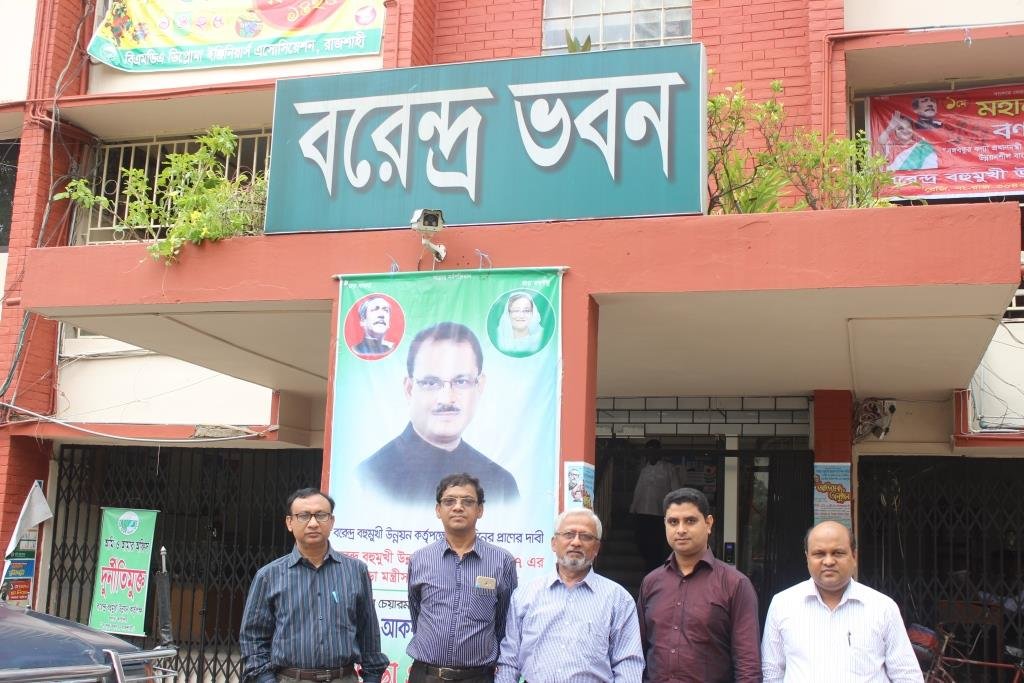Halting seasonal drought in Barind through efficient water resource management [Bangladesh]
- Creation:
- Update:
- Compiler: Jalal Uddin Md. Shoaib
- Editor: –
- Reviewers: William Critchley, Rima Mekdaschi Studer
Barendra elakay Khara proshaman
approaches_6143 - Bangladesh
View sections
Expand all Collapse all1. General information
1.2 Contact details of resource persons and institutions involved in the assessment and documentation of the Approach
Name of project which facilitated the documentation/ evaluation of the Approach (if relevant)
Establishing National Land Use and Land Degradation Profile toward Mainstreaming SLM Practices in Sector Policies (ENALULDEP/SLM)Name of the institution(s) which facilitated the documentation/ evaluation of the Approach (if relevant)
Department of Environment (DoE) - Bangladesh1.3 Conditions regarding the use of data documented through WOCAT
When were the data compiled (in the field)?
08/04/2020
The compiler and key resource person(s) accept the conditions regarding the use of data documented through WOCAT:
Yes
2. Description of the SLM Approach
2.1 Short description of the Approach
Introduction of sustainable water usage to prevent impacts of seasonal droughts in Barind region, Bangladesh
2.2 Detailed description of the Approach
Detailed description of the Approach:
Barind is a drought-affected area of Bangladesh. It covers about 7,770 sq. km, that is 41% of the North Western part of Bangladesh, spreading over 16 districts of Rajshahi and Rangpur Division. It is one of the driest areas in Bangladesh with comparatively high temperatures - though cooler in the wet season from mid-June to October. Rainfall in the area varies from about 1500 mm to 2000 mm per annum. Temperature ranges from 4 degree Celsius to 44 degree Celsius. The area is at a comparatively higher elevation than the adjoining floodplains. There are two main terrace levels - one at 40m and the other between 19.8 and 22.9 m above mean sea level. The total cultivable area of Barind is about 583,000 ha, of which 34% is loamy, 10% is sandy, and 49% is clay: the remaining 7% is of other composition.
In the 1980s, the area was predominantly single cropped, and yields were poor and subject to seasonal drought, from late February to early May (up to the onset of pre-monsoon). No crops could be grown during the "rabi" season (November to May). The impacts of drought were severe and affected food insecurity and livelihoods. To address the situation, the Bangladesh Agricultural Development Corporation (BADC) under the Ministry of Agriculture (MoA) initiated two projects. One in 1985: The Barind Integrated Area Development Project and subsequently in 1992, the Barind Multipurpose Development Authority (BMDA) as a separate institutional entity. Both the projects focused on a new approach to water extraction, distribution and management practices at institutional level. Deep tubewells were installed and maintained by BMDA, rather than privately (which is often practiced in other parts of the country).
Deep tubewells (DTWs) were installed to abstract water from 15-20 meters, and water was initially distributed through open channels. Later, these were fitted with smart card–operated electric/solar pumps to develop a drought-resilient irrigation system Both projects have helped the Barind region reduce poverty and achieve self-sufficiency in rice. Without supplementary irrigation, there would be crop failure.
Since it was established, BMDA has focused on halting seasonal drought in Barind, and increased cropping intensity by providing irrigation through 15,800 DTWs in different districts. That reduced the cost of irrigation water for one bigha (0.1ha) from about $40 to <$20. On the other hand initiation of smart cards and buried pipelines for water distribution increased the efficiency of water use and facilitated revenue collection by the BMDA. However abstraction of groundwater (GW) for irrigation triggered another issue - drawdown of GW in the area, which even led to abandoning shallow tubewells (STW) used for drinking water.
In 2004 BMDA initiated another project, to lift surface water from the Padma river to ponds/canals/rivers in the main land after re-excavation. These sources are used as reservoirs and at the same time contribute to GW recharge generally. At the same time, usage of solar power instead of electricity is another means of reducing the cost of pumping water.
BMDA again installed 490 dugwells where STW or DTW could not be constructed. These dug wells are used for safe drinking water and small-scale irrigation. These measures have meant that, at present, the area avoids seasonal drought in most of the locations. Potatoes, "boro" and transplanted "aman" occupy more than 50% of the cultivable land. In addition, provision of safe drinking water and improved communications have boosted the local economy. The approach embraces various technologies including (1) tapping river water (from the Ganges, Mahananda and Tangan rivers0; (2) storing water in creeks or ponds; (3) distribution to farm land through subsurface irrigation pipes (buried pipelines); (4) use of low lift pumps (LLP) with solar energy support ; (5) prepaid water metering - usage of smart cards; (6) conversion of derelict water bodies to become effective water reservoirs ; (7) dug wells with solar power for water abstraction; (8) orchard plantations where both surface or groundwater are limited; (9) plantations of trees and horticultural crops along road and channels to change the land cover; (10) usage of compost to improve soil health. All of these contribute to land degradation neutrality (LDN) in one way or another.
Finally BMDA's approach is to boost productivity in the drought affected Barind through its projects, and encouraged communities to adopt diversified land use: previously much land remained fallow during most of the year outside the monsoon. Institutions like Department of Agricultural Extension (DAE) and many NGOs promote a variety of seasonal, annual and perennial crops in the area, the use of balanced fertilizer, plantation of high density fruit crops. The impact of the BMDA approach has greatly changed the drought-affected Barind.
2.3 Photos of the Approach
General remarks regarding photos:
All these pictures demonstrate the usage of surface water for irrigation and livelihoods in Barind.
2.5 Country/ region/ locations where the Approach has been applied
Country:
Bangladesh
Region/ State/ Province:
Rajshahi
Comments:
Barind which was the driest area of Bangladesh, has now changed its landscape to green.
Map
×2.6 Dates of initiation and termination of the Approach
Indicate year of initiation:
1992
Comments:
Barind Multipurpose Development Authority (BMDA) is continuing with more development projects to provide irrigation facilities with more options. Cropping intensity has increased, and most of the single cropped land has been transformed to double and triple cropped land.
2.7 Type of Approach
- project/ programme based
2.8 Main aims/ objectives of the Approach
To provide irrigation water for cropping in dry season.
To increase cropping intensity in drought affected areas of Barind.
To manage land use or land cover in Barind.
To mobilize community on rational usage of soil and water resources.
2.9 Conditions enabling or hindering implementation of the Technology/ Technologies applied under the Approach
social/ cultural/ religious norms and values
- enabling
Increased livelihood options and access to education, marketing, health services.
availability/ access to financial resources and services
- enabling
Increased access to financial institution.
institutional setting
- enabling
All technical support provided by BMDA.
collaboration/ coordination of actors
- enabling
BMDA supports all action in related to irrigation, maintenance, water supply etc.
legal framework (land tenure, land and water use rights)
- enabling
Lands owned by land users
policies
- enabling
Land users are in the line of BMDA policies.
land governance (decision-making, implementation and enforcement)
- enabling
Traditional approach.
knowledge about SLM, access to technical support
- enabling
Community has access to technical support.
markets (to purchase inputs, sell products) and prices
- enabling
All inputs are available in the area.
workload, availability of manpower
- enabling
Available, people are getting work now.
3. Participation and roles of stakeholders involved
3.1 Stakeholders involved in the Approach and their roles
- local land users/ local communities
Men and women are involved in the process
Growing crops as of their choice, for example: rice, fruits, vegetables or orchard trees.
- community-based organizations
Farmers have societies,
Influenced in choice of crops, etc.
- NGO
Several NGO s are functional in the area.
Most of them are supporting credit and marketing facilities
- local government
Local institutions involved in the process
Capacity building, advisory services on fertilizer usage, crop selection etc.
If several stakeholders were involved, indicate lead agency:
BMDA is working as lead agency
3.2 Involvement of local land users/ local communities in the different phases of the Approach
| Involvement of local land users/ local communities | Specify who was involved and describe activities | |
|---|---|---|
| initiation/ motivation | passive | Farmers are using irrigation water for their crops supplied by BMDA and they pay revenue |
| planning | passive | Farmer nor the community are involved in the planning process |
| implementation | passive | Land users allow to set buried pipelines under their fields. |
| monitoring/ evaluation | passive | Land users are not involved in the M&E but they participate in the events organized. |
| none | Land users only choose their crops to be grown |
3.3 Flow chart (if available)
Description:
Barind Multipurpose Development Authoroty (BMDA) is the symbol of development in Barind area also of the Tista fldooplain and the Old Himalayan piedmont plain.
Author:
ShoaibJU
3.4 Decision-making on the selection of SLM Technology/ Technologies
Specify who decided on the selection of the Technology/ Technologies to be implemented:
- mainly land users, supported by SLM specialists
Specify on what basis decisions were made:
- evaluation of well-documented SLM knowledge (evidence-based decision-making)
- research findings
- personal experience and opinions (undocumented)
4. Technical support, capacity building, and knowledge management
4.1 Capacity building/ training
Was training provided to land users/ other stakeholders?
Yes
Specify who was trained:
- land users
- field staff/ advisers
If relevant, specify gender, age, status, ethnicity, etc.
BMDA has trained staff to care for the system by and large. There are both male and female staff.
Form of training:
- on-the-job
- demonstration areas
Subjects covered:
Buried pipeline maitenance, good seed production, marketing etc.
4.2 Advisory service
Do land users have access to an advisory service?
Yes
Specify whether advisory service is provided:
- at permanent centres
Describe/ comments:
BMDA has field offices at each upazila to look after the system
4.3 Institution strengthening (organizational development)
Have institutions been established or strengthened through the Approach?
- yes, greatly
Specify the level(s) at which institutions have been strengthened or established:
- local
- regional
Describe institution, roles and responsibilities, members, etc.
BMDA has it headquarters at Rajshai city and sub-offices at all "upazila" to where the pipeline extended.
Specify type of support:
- capacity building/ training
- equipment
4.4 Monitoring and evaluation
Is monitoring and evaluation part of the Approach?
Yes
Comments:
BMDA monitors groundwater levels regularly, and also the pipelines and other operational activities.
If yes, is this documentation intended to be used for monitoring and evaluation?
Yes
Comments:
During the documentation of the SLM best practices of the Banrind area intensive conversations, meetings and workshops were organized with all officials of headquarter and filed offices.
4.5 Research
Was research part of the Approach?
No
5. Financing and external material support
5.1 Annual budget for the SLM component of the Approach
If precise annual budget is not known, indicate range:
- 10,000-100,000
5.2 Financial/ material support provided to land users
Did land users receive financial/ material support for implementing the Technology/ Technologies?
Yes
If yes, specify type(s) of support, conditions, and provider(s):
All infrastructural establishment cost were born by BMDA
5.3 Subsidies for specific inputs (including labour)
- none
- equipment
| Specify which inputs were subsidised | To which extent | Specify subsidies |
|---|---|---|
| stone | fully financed | |
- construction
| Specify which inputs were subsidised | To which extent | Specify subsidies |
|---|---|---|
| roads | fully financed | |
- infrastructure
| Specify which inputs were subsidised | To which extent | Specify subsidies |
|---|
5.4 Credit
Was credit provided under the Approach for SLM activities?
No
5.5 Other incentives or instruments
Were other incentives or instruments used to promote implementation of SLM Technologies?
Yes
If yes, specify:
Installation and maintenance cost borne by BMDA, but farmers have to pay for water through smart cards (Pre-paid).
6. Impact analysis and concluding statements
6.1 Impacts of the Approach
Did the Approach empower local land users, improve stakeholder participation?
- No
- Yes, little
- Yes, moderately
- Yes, greatly
Farmers are using irrigation water for their crops
Did the Approach enable evidence-based decision-making?
- No
- Yes, little
- Yes, moderately
- Yes, greatly
As of now buried pipe lines for irrigation water supply are being adopting in many areas of the country.
Did the Approach help land users to implement and maintain SLM Technologies?
- No
- Yes, little
- Yes, moderately
- Yes, greatly
Usage of water rationally: BMDA installs control meters for each of the land user.
Did the Approach improve coordination and cost-effective implementation of SLM?
- No
- Yes, little
- Yes, moderately
- Yes, greatly
The approach had changed the Barind ecosystem at large.
Did the Approach improve knowledge and capacities of land users to implement SLM?
- No
- Yes, little
- Yes, moderately
- Yes, greatly
Land users enable to use irrigation water for growing crops of their choice
Did the Approach improve knowledge and capacities of other stakeholders?
- No
- Yes, little
- Yes, moderately
- Yes, greatly
Other local institutions in Barind area are involved in the system.
Did the Approach build/ strengthen institutions, collaboration between stakeholders?
- No
- Yes, little
- Yes, moderately
- Yes, greatly
Adoption of the irrigation system at all areas of the Barind.
Did the Approach mitigate conflicts?
- No
- Yes, little
- Yes, moderately
- Yes, greatly
Stakeholders are enable to use water as they like.
Did the Approach empower socially and economically disadvantaged groups?
- No
- Yes, little
- Yes, moderately
- Yes, greatly
The area was resource poor before the 1990s. Now livelihoods of the community improved largely.
Did the Approach improve gender equality and empower women and girls?
- No
- Yes, little
- Yes, moderately
- Yes, greatly
Man and women are engaged themselves in their land and crops.
Did the Approach encourage young people/ the next generation of land users to engage in SLM?
- No
- Yes, little
- Yes, moderately
- Yes, greatly
Interventions with new crops, specially high value fruits etc in the area.
Did the Approach improve issues of land tenure/ user rights that hindered implementation of SLM Technologies?
- No
- Yes, little
- Yes, moderately
- Yes, greatly
Land tenure system is traditional, where large areas are sublet or leased to the individuals or groups by the land owners.
Did the Approach lead to improved food security/ improved nutrition?
- No
- Yes, little
- Yes, moderately
- Yes, greatly
The area produces a large amount of cereals, potatoes, vegetables, fruits etc.
Did the Approach improve access to markets?
- No
- Yes, little
- Yes, moderately
- Yes, greatly
Fruits and paddy rice have good markets.
Did the Approach lead to improved access to water and sanitation?
- No
- Yes, little
- Yes, moderately
- Yes, greatly
Safe drinking water where tubewells do not function, and sanitation also developed as the system.
Did the Approach lead to more sustainable use/ sources of energy?
- No
- Yes, little
- Yes, moderately
- Yes, greatly
Using solar power to abstract dug well water greatly facilitates the community.
Did the Approach improve the capacity of the land users to adapt to climate changes/ extremes and mitigate climate related disasters?
- No
- Yes, little
- Yes, moderately
- Yes, greatly
Vegetative cover in the Barind has changed the ecosystem at large.
Did the Approach lead to employment, income opportunities?
- No
- Yes, little
- Yes, moderately
- Yes, greatly
Local people are having work everywhere of the Barind.
6.2 Main motivation of land users to implement SLM
- increased production
Cropping intensity increased
- increased profit(ability), improved cost-benefit-ratio
Low cost of irrigation water contributes to benefits for the land users.
- reduced land degradation
Halts or reduces seasonal drought
- reduced risk of disasters
Less climate extremes, no crop loss due to drought. Temperature relatively cooler than before.
- rules and regulations (fines)/ enforcement
No social unrest
- prestige, social pressure/ social cohesion
Livehood improved greatly.
- environmental consciousness
Local people are now aware of the environment. They grow trees around their homesteads, preserve water in their ponds etc.
6.3 Sustainability of Approach activities
Can the land users sustain what has been implemented through the Approach (without external support)?
- yes
If yes, describe how:
Buried pipeline irrigation has changed the Barind area greatly.
6.4 Strengths/ advantages of the Approach
| Strengths/ advantages/ opportunities in the land user’s view |
|---|
| More crops could be grown throughout the year, |
| Crop diversity is possible, annual, perenial or seasonal |
| Secure crop production |
| Strengths/ advantages/ opportunities in the compiler’s or other key resource person’s view |
|---|
| Minimum loss of irrigation water |
| Surface (river) water usage minimize stress on ground water usage |
| Improved ground water recharge |
| Safe drinking water where tubewell is not available. |
| Usage of solar power for lifting water from dug well or for lifting water to buried pipeline |
| Introduction of water meters reduces misuse of irrigation water |
6.5 Weaknesses/ disadvantages of the Approach and ways of overcoming them
| Weaknesses/ disadvantages/ risks in the land user’s view | How can they be overcome? |
|---|---|
| The system could be implemented at single farmer level | Developing community approach with the support of the government |
| Weaknesses/ disadvantages/ risks in the compiler’s or other key resource person’s view | How can they be overcome? |
|---|---|
| Very high pressure on land and soil resources | Lower water consumptive crops could be introduced |
| Severe soil nutrient depletion may develop | Use of manure/ compost or organic matter or crop rotation to enrich soil |
7. References and links
7.1 Methods/ sources of information
- field visits, field surveys
Intensive field visit with responsible officers (5) from BMDA and interview with beneficiaries (30) .
- interviews with land users
Especially the farmers (5) who used to grow very high density fruits crops and of solar powered dugwell (3)
- interviews with SLM specialists/ experts
10 officers from different institutions, like BMDA, DAE, University of Rajshahi, SRDI, NGO, Fishries etc.
- compilation from reports and other existing documentation
Few official docments of design and plan of pipelines, dugwell etc.
7.3 Links to relevant information which is available online
Title/ description:
Baring Multipupose Development Authority
URL:
http://www.bmda.gov.bd/site/page/2ea693ba-ac10-4ada-b304-111d72a72105/-#
Title/ description:
Pro-Poor Groundwater Development
URL:
https://openknowledge.worldbank.org/bitstream/handle/10986/33246/Pro-Poor-Groundwater-Development-The-Case-of-the-Barind-Experiment-in-Bangladesh.pdf?sequence=5
Links and modules
Expand all Collapse allLinks
No links
Modules
No modules


